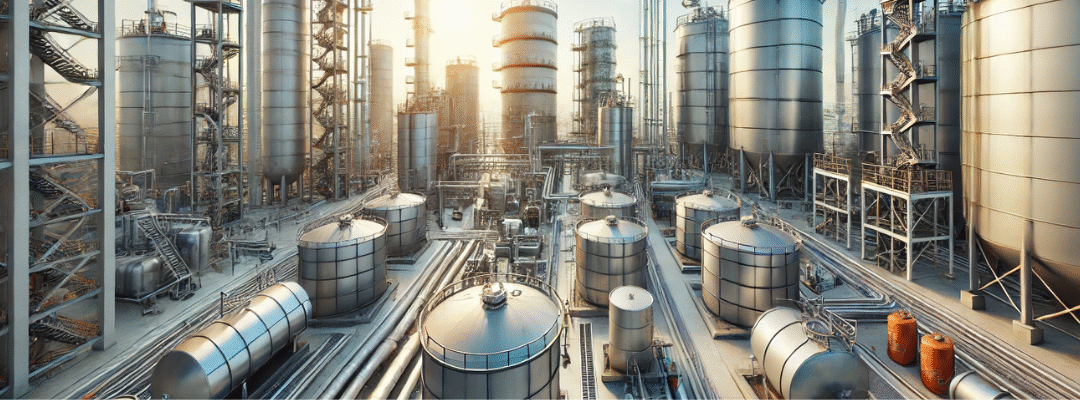Industrial storage tanks are essential for storing a wide range of liquids and gases—such as water, oil, chemicals, and even solids in slurry form. The type of tank chosen depends on the nature of the substance being stored, the operating environment, and applicable safety regulations.
Below is a breakdown of the most common types of industrial tanks, including their uses, benefits, and limitations.
1.Fixed Roof Tanks
What They Are: Cylindrical tanks with a permanently attached roof.
Best For: Non-volatile liquids like water, light chemicals, and some petroleum derivatives.
Pros:
Cost-effective
Simple design and installation
Cons:
Prone to vapor losses with volatile liquids
Limited vapor space
2.Floating Roof Tanks
What They Are: Tanks with a roof that floats on the liquid’s surface, adjusting with its level.
Types:
External Floating Roof
Internal Floating Roof
Best For: Volatile liquids like crude oil, gasoline, and solvents.
Pros:
Reduces vapor loss and VOC emissions
Minimizes fire risk
Cons:
More complex and costly than fixed-roof tanks
Requires regular inspection
3.Open-Top Tanks
What They Are: Tanks with no roof, leaving contents exposed.
Best For: Wastewater treatment, temporary water storage, or slurries.
Pros:
Easy to clean and access
Low cost
Cons:
Vulnerable to contamination, evaporation, and weather
4.Cone-Bottom Tanks
What They Are: Tanks with a conical base for complete drainage.
Best For: Viscous fluids, chemicals, and grains.
Pros:
Allows full discharge
Simplifies cleaning
Cons:
Requires specialized supports
5.Horizontal Cylindrical Tanks
What They Are: Tanks lying flat on supports or saddles.
Best For: Storing diesel, heating oil, or smaller volumes of chemicals.
Pros:
Fits low-clearance spaces
Compact footprint
Cons:
Harder to clean
Requires more floor space
6.Vertical Cylindrical Tanks
What They Are: Upright tanks commonly used for bulk liquids.
Best For: Water, chemicals, and fuels in high volumes.
Pros:
Maximizes vertical space
Easier maintenance access
Cons:
Needs strong foundation support
7.Spherical Tanks
What They Are: Ball-shaped tanks designed to store gases under pressure.
Best For: Storing LPG, LNG, propane.
Pros:
Excellent for pressure equalization
Safer under extreme conditions
Cons:
Expensive and technically complex to build
8.LNG/LPG Storage Tanks
What They Are: Cryogenic tanks built for liquefied gases at extremely low temperatures.
Best For: Natural gas, propane, and butane storage.
Pros:
Allows bulk gas storage in liquid form
Insulated for thermal control
Cons:
High construction and maintenance costs
9.Underground Storage Tanks (USTs)
What They Are: Tanks buried beneath the ground.
Best For: Fuel stations, water reserves, and hazardous chemicals.
Pros:
Saves surface space
Reduces fire risk
Cons:
Difficult to inspect or repair
Environmental risk if leakage occurs
10.Above-Ground Storage Tanks (ASTs)
What They Are: Freestanding tanks installed on the surface.
Best For: Water, fuel, and chemical storage.
Pros:
Easier to inspect and maintain
Faster installation
Cons:
Exposed to temperature extremes and weathering
11.Pressure Vessels
What They Are: Cylindrical or spherical tanks built to store high-pressure gases or liquids.
Best For: Oxygen, nitrogen, hydrogen, and other industrial gases.
Pros:
High-pressure handling
Durable and explosion-resistant
Cons:
Heavily regulated
High cost and frequent inspections required
12.Double-Walled Tanks
What They Are: Tanks with two layers—inner for containment, outer for leak detection and secondary protection.
Best For: Fuel, toxic chemicals, and hazardous liquids.
Pros:
Leak protection
Environmental compliance
Cons:
More expensive than single-wall versions
13.Bolted Steel Tanks
What They Are: Modular steel tanks bolted together on-site.
Best For: Water supply, fire suppression, or industrial fluids.
Pros:
Relocatable
Fast installation
Cons:
Needs seal inspections
Corrosion-prone without coatings
14.FRP (Fiberglass Reinforced Plastic) Tanks
What They Are: Composite tanks known for high corrosion resistance.
Best For: Chemical, wastewater, or saltwater applications.
Pros:
Lightweight and non-corrosive
Long lifespan with minimal maintenance
Cons:
Limited pressure capacity
UV protection required for outdoor use
15.Polyethylene (Plastic) Tanks
What They Are: Molded tanks made from HDPE or similar plastic polymers.
Best For: Water, fertilizers, and light chemicals.
Pros:
Lightweight and affordable
Easy to transport and install
Cons:
Susceptible to UV degradation
Limited pressure and temperature resistance
16.Cryogenic Tanks
What They Are: Insulated tanks designed for extreme low temperatures.
Best For: Liquid nitrogen, oxygen, and LNG storage.
Pros:
Maintains cryogenic conditions
Reduces volume of stored gases
Cons:
Expensive and specialized
Requires strict monitoring
Conclusion
Choosing the right industrial storage tank hinges on a variety of factors—material type, storage temperature, pressure needs, space availability, and regulatory compliance. Whether you’re storing water, hazardous chemicals, or compressed gases, selecting the appropriate tank type ensures safety, durability, and operational efficiency.

